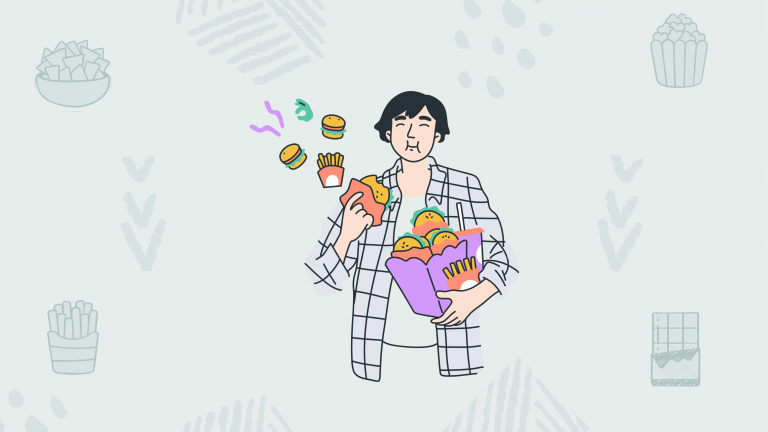The Snacking Spiral of Hunger vs. Habit
Ah, the Snacking Spiral, where hunger and habit tangle! Ever found yourself diving into a bag of chips or unwrapping a chocolate bar, not from hunger pangs, but just… because?
Maybe boredom’s kicking in, or stress is cranking up, and suddenly, munching seems like the best activity or solace. It’s a scene all too familiar in the drama of daily life, where the lines between needing a nibble and craving comfort get all fuzzy and crossed.
It’s not just about not having enough willpower. There’s more to the story. Our brains are like backstage operators, pulling the strings, making us reach for that cookie or crisp when we’re down or just dragging.
In fact, we’re wired to find a bit of solace in snacking, especially when the emotional weather gets stormy or when boredom looms large on the horizon.
The Science of Snack Cravings
Our eating habits are deeply intertwined with our emotional state and neurological responses. When we’re bored or stressed, our brain seeks a quick reward, and snacking becomes an easy target. Dopamine, the neurotransmitter associated with pleasure and reward, spikes when we eat tasty food, temporarily lifting our mood or distracting us from monotony.
Furthermore, stress triggers the release of cortisol, often leading to cravings for high-fat, high-sugar foods that provide a quick energy boost and emotional relief. This cycle is reinforced over time, creating neural pathways that equate snacking with emotional comfort or stimulation, making the habit hard to break.
Diving deeper into the mechanics, it’s fascinating how our brains and bodies collaborate in this snacking saga. The limbic system, our brain’s emotion center, gets especially chatty when we’re feeling blue or under pressure, nudging us towards the snack drawer.
It’s like a comfort-seeking missile, zeroing in on the quickest source of solace: food, glorious food, preferably the kind that’s rich and sugary or salty and crunchy.
But there’s more to it than just a quest for feel-good vibes. Our body’s energy regulation system gets in on the act too. When cortisol levels rise, it’s not just a signal for stress; it also messes with our hunger hormones, like ghrelin, ramping up the appetite even when we’re not truly in need of fuel. Plus, let’s not forget about insulin, the hormone that helps manage blood sugar levels.
After a sugar or carb-heavy snack, a spike in blood sugar leads to an insulin surge, followed by a sharp drop, which then triggers yet another hunger pang, perpetuating the snack cycle.
It’s a complex dance of hormones and neurotransmitters, making our snacking habits less about actual hunger and more about an intricate biochemical tango driven by our emotions and stress levels.
Subscribe to newsletter
Get your Gut Health Starter Guide right now.
Elevate your Tuesdays with practical, science-backed wisdom propelling you forward on your gut health journey.

Strategies to Curb Emotional Snacking
To combat boredom or stress-induced snacking, we need to develop mindful eating practices and alternative coping mechanisms:
- Recognize the Triggers: Keep a food diary to identify when and why you snack. Noting your emotions and activities can highlight patterns and triggers.
- Healthy Alternatives: Have nutritious snacks like fruits, nuts, or whole grains within reach. These healthier options can satisfy the urge to snack without the guilt.
- Mindful Eating: Practice eating slowly and without distractions, savoring the taste and texture, to enhance satisfaction and prevent overeating.
- Stress Management: Adopt stress-reducing techniques such as exercise, meditation, or hobbies that engage you positively and divert the urge to snack.
- Routine and Structure: Establish regular meal and snack times to prevent random eating and build a structured eating pattern.
Triumph Over Temptation
Sarah, a freelance writer, shares her experience of transforming her snacking habits. “I used to snack all the time while working from home, especially when I hit a creative block or felt anxious about deadlines. It was my way of coping with stress and boredom,” she reveals.
After noticing the toll it took on her health and productivity, Sarah decided to make a change. “I started by identifying my trigger times and swapped out chips and sweets for fruits and nuts. It was challenging at first, but I also took up yoga to manage stress and scheduled specific times for meals and snacks.”
Sarah’s story exemplifies the positive shift that can happen when we address the underlying causes of our snacking habits. “Not only have I improved my diet, but I also feel more focused and less anxious. Snacking no longer controls me; I control it. It’s liberating to break free from the cycle of emotional eating.”


















